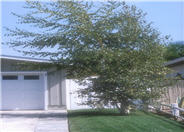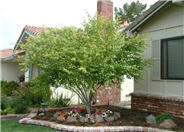
Common name:European White Birch
Botanical name:Betula pendula
This medium-size weeping tree will grow to about 40' tall and has a whitish-brown bark with deciduous green leaves.

Common name:Grosso Hedge Lavender
Botanical name:Lavandula X intermedia 'Grosso'
Long-stemmed Lavender has beautiful violet-colored plumes in the summer. Very drought tolerant and it is a great plant to create that Mediterranean effect.

Common name:John Dourley Manzanita
Botanical name:Arctostaphylos 'John Dourley'
This small low growing shrub has grayish green leaves with pink and white flowers that bloom in winter and early spring.

Common name:Japanese Maple
Botanical name:Acer palmatum
This magnificient plant can used as a small tree or shrub. It is deciduous with graceful leaves which have a scarlet color in spring as it leafs out. Leaves later turn orange or yellow in fall. It is slow growing to 20', and requires shelter from the hot sun. The leaves of this tree are small, light green in color, and deeply lobed. It should also be noted that this tree remains spectacular throughout all seasons. (2nd photo courtesy of Steve Mullany)

Common name:Common Field or Slender Sedge
Botanical name:Carex praegracilis
This California native grass can tolerate occasional flooding or standing water as it is found in marshes and wetlands. It does make a great lawn substitute as it can be mowed, will take sun and part sun and need watering once a week in hot summer months. This sedge uses much less water than sod. It can be used for erosion control also.

Common name:Japanese Boxwood
Botanical name:Buxus microphylla japonica
Japanese Boxwood is often used as a hedge. It is compact, with small bright green leaves. It can reach 4-6' tall and wide or be kept smaller through pruninig. It can be sheared to shape. It does better in areas with milder winters. It prefers full sun and a moderate amount of water.
More than half of the water used at your home is for outside purposes. Studies show that on average, half of the water used outdoors is wasted. The leading cause of waste is incorrectly set and poorly managed irrigation controllers. The second biggest cause of wastage is broken irrigation equipment that goes undetected. There are a few basic things you can do to make a big difference in your water use.
Click in the green box for more information
Designer: Jeff Gamboni Landscape Archite
Photographer: GardenSoft
Physical weed control, including mulching, or hand removal protects the watershed from harmful chemicals.
Develop healthy soil for plants that are vigorous and naturally pest-resistant.